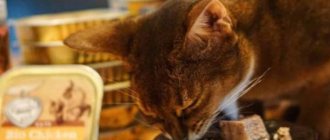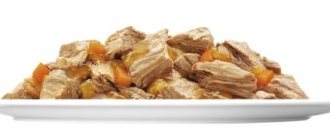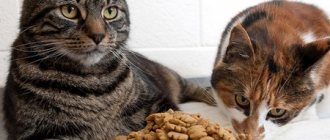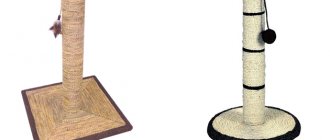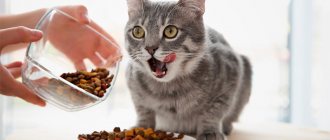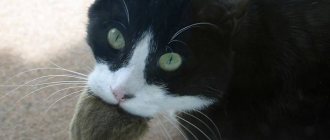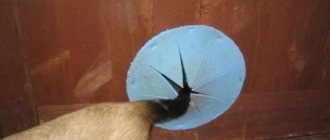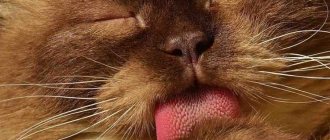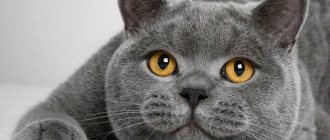Historically, the cat originated from the southern arid regions. This is an obligate predator, adapted to feeding on whole carcasses of small animals. Knowing this allows us to highlight the main features of cat nutrition, which, in turn, are necessary to understand how to properly feed cats.
Principles of natural nutrition
With natural feeding, pets do not receive nutritious industrial mixtures, but products prepared by humans themselves. Such food must meet certain requirements:
- Completely meet the cat's needs for basic and additional nutrients.
- Be safe for your pet, that is, do not contain pathogenic bacteria and parasites.
- Natural food must not contain substances harmful to cats - GMOs, hormones, pesticides, components that are contraindicated for pets.
If you don’t know what diet is best to choose for your pet, we recommend reading the article on cat nutrition on our portal.
The diet of animals must include:
- Squirrels. A predator, which is a cat, must obtain this element mainly from meat (about 80% of the diet).
- Fats. Preference should be given to products of animal origin, while the plant component, although in a smaller part, is necessary.
- Carbohydrates. They are a source of energy for any mammal, so they must be in a cat’s diet every day, but in small quantities.
- Cellulose. Ensures proper functioning of the gastrointestinal tract and complete digestion of food, therefore it is a mandatory ingredient in the daily diet with a natural diet.
- Vitamins, micro- and macroelements. They compensate for the lack of calcium, phosphorus, magnesium, iodine, selenium, and other components that provide the animal with healthy skin, coat, and proper functioning of the cardiovascular and musculoskeletal systems.
- Water. It should always be present in the cat’s natural diet in its pure form and in unlimited quantities.
When feeding a natural diet, it is important to ensure that the cat does not have vitamin deficiency, in order to notice this condition in time, read the article here.
Mr. Cat recommends: advantages and disadvantages
Proponents of natural cat nutrition often talk about the exceptional advantages of such a diet, sometimes forgetting about its disadvantages. And they are important:
- There is a high risk of infection for pets when using low-quality products or failing to comply with their storage conditions. This is especially important if pets are “on raw meat”.
- Difficulty achieving a properly balanced diet.
- The need to purchase and regularly include special vitamin and mineral supplements in animal nutrition.
- Increased time and financial costs for purchasing and preparing a daily diet.
- The most basic knowledge about feline nutrition. They are necessary to ensure that cats’ nutrition is complete and balanced.
- The need for a special diet in case of animal illness. It is much more difficult to find it with a natural diet.
- Maintaining hygiene when storing and preparing cat food is an important factor in maintaining the health of your pets.
But the benefits of natural cat nutrition still attract many owners:
- There are no chemical or artificial components in cat food.
- All pets like a diet of meat; such feeding is natural for predators.
- Possibility of preparing meals taking into account the taste preferences of cats.
- With the correct selection of products, this feeding regimen has a more beneficial effect on the pet’s body.
When feeding cats naturally, regularity of food intake is very important.
If dry food can always be in a cat’s bowl and the animal chooses when and how much to eat, then meat, cereals, dairy products, fruits and vegetables should be given to the pet as many times a day as required by age, weight and size:
- Up to three months, young animals are fed six times a day.
- From three to four - five.
- Four to six month old kitten - four times.
- From six months the cat is fed three times a day.
- After a year, the cat is either transferred to two meals a day, or continues to be fed three times a day, depending on the individual characteristics and preferences of the pet.
It is recommended to give a single dose of natural food to the cat at the same time and in a certain place that the pet loves. The temperature of the food should be comfortable for the animal; food from the refrigerator should be heated.
If there are several pets in the house, each should receive their portion in a separate bowl.
Water should always be in an accessible place, clean and of high quality.
Basic feeding rules
How to feed a cat natural food at home: nutritional features
Caring for a pet requires compliance with certain rules:
- food for cats should be uncombined; mixing ready-made industrial products with self-prepared food leads to hypervitaminosis and vitamin deficiency at the same time;
- frequency of intake and type of diet directly depend on the individual characteristics of the pet;
- when choosing ready-made dry biscuits or wet canned food, it is better to give preference to one manufacturer, since alternating different brands will cause an imbalance of nutrients;
- The freshness of the food is important; four-legged animals should not be given food that has passed its expiration date;
- the cat should have its own corner for eating;
- Equally important is compliance with the drinking regime; the animal must have free access to water;
- cold foods cause disruption of the gastrointestinal tract, hot foods cause injuries to the mucous membranes;
- If the pet cannot eat large and hard pieces, then they need to be crushed.
Important! The transition to a new type of diet is carried out gradually. A sudden change can cause starvation and further health problems.
Protein sources
Animal proteins are necessarily the main component of a cat’s natural diet. They most often serve the following types of meat:
- poultry - chicken, turkey, some parts of duck;
- beef;
- rabbit and lamb meat;
- for kittens, it is desirable to have puree or small pieces of meat with vegetables;
- low-fat varieties of fresh sea fish.
Meat and fish can be used both raw and boiled. In the latter case, it is necessary to remove all the bones, otherwise they can damage the walls of the stomach, intestines, esophagus, and larynx.
When feeding raw meat, it must first be thoroughly frozen, preferably in industrial refrigeration chambers at a temperature of about -40 °C. Or keep for at least three days in household freezers.
After defrosting, be sure to rinse thoroughly with plenty of clean running water.
Fish should not be given to cats at any age more than once or twice a week.
Ready-made meat puree (baby food) is allowed for small kittens and adults with sensitive digestion or diseases of the gastrointestinal tract.
The following types of protein are also acceptable; they are included in pets’ diets in smaller quantities than meat:
- chicken, quail, turkey, goose eggs - mainly raw;
- low-fat cottage cheese and kefir;
- hard cheeses with a minimum amount of salt and unsweetened natural yoghurts.
If the cat does not like the taste of cottage cheese, it can be mixed with yogurt, fermented baked milk, or kefir. Cheese should not be given more than once every seven days.
Reproduction
They reach sexual maturity at about three years of age. The mating season usually falls between January and March. The female, ready for fertilization, releases a specific aroma, the smell of which cats are drawn to. The males, gathering in a group, win the cat by fighting with each other. It often happens that among the males there are feral domestic cats lost in the forest. Therefore, it happens that the population mixes. After conception, the female prepares a den for herself.
Pregnancy of a wild cat lasts from 2 to 2.5 months. At one time, a cat manages to bear from 2 to 7 kittens, which are born blind, deaf and with small fluff on the body. After the birth of the kittens, the male leaves the female, returning to his usual life.
Until 3-4 months, the cubs are fed with mother's milk. They are under constant maternal protection from enemies. Babies live with their mother for up to 6 months. At this age, they already know how to hunt and climb trees. From nine months, female cats are ready to breed.
Wild cat ready to breed
Sources of fats
This element must be included in a cat’s natural diet, since it is not only, along with carbohydrates, a source of energy, but also supplies the body with many vitamins:
- A - improves vision, is responsible for the condition of the skin and coat;
- D - is of great importance for the formation of the skeleton;
- E - strengthens muscles, regulates the normal functioning of the genitourinary system;
- K - is an important element for strengthening joints and bones, and the functioning of the cardiovascular system.
In addition, fats give food an attractive taste and smell, promote intensive growth and harmonious development of the animal. Their share in the pet’s diet with natural nutrition should be at least 20%.
If it is not possible to provide the animal with food with a sufficient amount of these components, then fish oil can be added to it.
What does a cat prefer?
What do cats like to eat, based on their sense of taste? In this case, it should be noted that cats are indifferent to salty foods, but they like sour foods. As for sweets, it is worth noting that cats do not have the gene that is responsible for developing sensitivity to sweets. Therefore, a cat that decides to profit from something sweet makes its choice based on smell rather than taste. So, many cats love to chew toffees, eat marmalades, honey and condensed milk.
It should be noted that the most attractive taste for any cat is umami - this is the taste of protein substances, for example, glutamate and other nucleotides. Every owner can notice how a cat eats flowers, and these can be both indoor plants and flowers growing outside. The animal does this in order to obtain the necessary vitamins contained in certain plants. Cats especially love to eat sprouted wheat.
Carbohydrates and fiber in natural foods
To replenish this important nutritional element and ensure high-quality digestion of food with a natural diet, raw, boiled, steamed vegetables, fruits and berries must be included in the cat’s diet.
Not all animals are attracted to the taste of apples, greens, cranberries, blueberries, legumes, and carrots. You can add a little sunflower or olive oil to this food, and also mix it with pieces of meat or puree.
Preference should be given to cauliflower, broccoli, lettuce, zucchini, pumpkin, and apples. But some vegetables are on the list of prohibited foods (more on that below) and are not recommended for cats. Oatmeal and pearl barley porridge can be included in the diet of pets. It is not recommended to give semolina porridge, i.e. wheat.
Myth No. 1. The cat will not eat junk food
This is far from true. The animal cannot be aware of the harm or benefit of food. It only focuses on the smell and taste of food. For example, a cat will happily eat cheap industrial food, although it is extremely harmful. A lot of chemicals are added to such food to enhance its smell and taste. It is this smell that attracts cats.
Therefore, choosing healthy food for the animal is the owner’s task. You should choose high-quality food containing meat, not by-products and food additives.
Vitamins and minerals
These elements are very important in a natural diet. To replenish them, cats should be given specially grown grass or sprouted oats. Recommends selectively adding brewer's yeast to animal food to replenish B vitamins.
Since the usual food that a person can offer to their pets, as a rule, contains an insufficient amount of vitamins and minerals, when feeding cats on a natural basis, it is imperative to give cats special vitamin and mineral complexes. They contain important nonessential and essential amino acids, usually Omega-3 and 6 fatty acids.
Taurine must be included in the diet; it is one of the most significant additional elements in a cat’s diet. This amino acid in the cat’s body, unlike the human body, is not formed independently. If it is lacking in the daily diet, the functioning of the following systems of the pet’s body deteriorates: visual, cardiovascular and reproductive, gastrointestinal tract, and there is also a decrease in overall tone.
It is recommended to give vitamin-mineral complexes to pets in exact dosages according to the instructions, since their excess is just as undesirable as their deficiency.
Features of feeding cats at different ages
The daily amount depends on:
- from age;
- health conditions;
- body weight;
- cat breed.
Before the first six months of life, cats require larger volumes for normal development than sexually mature pets. Babies are fed up to 4 times a day in minimal portions.
For cats older than 6 months, the daily dose is divided into three times, for mature animals - into 1-2 doses. Older pets gradually lose their appetite; this problem is associated with slow metabolism and tooth loss. Cats over 7 years old require one meal a day.
List of prohibited products
If the owner has decided to switch the pet to natural food, he should not only become familiar with the basics of cat dietetics, but also be well aware of the foods that are strictly prohibited for the cat.
You should not feed your pet such delicacies from the human table as:
- baked;
- flour;
- roast;
- salty;
- sweet;
- pickled;
- smoked;
- spicy.
It is better to purchase meat from trusted sources; you need to be firmly convinced that it does not contain antibiotics, GMOs, or hormones.
Prohibited foods for cats
You can make a whole list of natural products prohibited for cats:
- Meat - pork in the form of fillet and even liver. Firstly, it is a too fatty product, and, secondly, it is often affected by pathogenic microbes, for example, Trichomonas.
- Fish can only be fresh, sea and lean, which in the conditions of central Russia makes its inclusion in the diet of cats impossible.
- Lard and internal fat in their pure form will cause diarrhea and vomiting in your pet.
- Chocolate contains theobromine, which is dangerous for cats, which accumulates in the body in its pure form and can be fatal very quickly.
- White cabbage.
- Onion and garlic.
- Eggplants and tomatoes.
- Potato.
- Whole cow's milk.
- Alcohol, coffee, tea and many other products.
This list is far from complete; it shows only the main products of the human table that people often try to treat their pets with. Therefore, read the article about what you should not feed cats and kittens.
Foods contraindicated for cats
There is no worse enemy to a cat’s health than a compassionate housewife who strives to treat her pet to something delicious from her table. Of course, if the measure is followed, there will be no immediate harm to health, but no one has ever seen a cat capable of self-restraint in food. The following foods are contraindicated for felins:
- Fried, smoked, sausages.
- Salted, pickled.
- Borscht, soup, pasta.
- Chocolate, sweets, flour, baked goods.
Fatty pork is contraindicated from raw foods. When cutting meat, a cat can become infected with helminths. Some typical cat foods can be harmful in excessive quantities. So, it is better not to use milk for adult animals. The insides of raw river fish may contain the antivitamin substance thiaminase. Pollock and its analogues contain a compound that interferes with the absorption of iron and causes anemia - trimethylamine oxide.
Human food is contraindicated for cats
Recipe examples
The approximate diet of cats on a natural diet should be as follows (grams per day):
| Product | Adult cat | Kitty | |
| 1-3 months | 3-6 months | ||
| Meat products | 80-120 | 10-60 | 60-80 |
| Fish and seafood | 80-100 | 8-50 | 50-60 |
| Fermented milk or milk (for kittens) | 100-200 | 30-100 | 100-130 |
| Cottage cheese and cheeses | 30-50 | 5-10 | 10-15 |
| Cereals | 50-80 | 20-50 | 50-70 |
| Animal fats | 5-8 | 1-2 | 3 |
| Vegetable fats | 3-5 | 0,5-1 | 1-2 |
| Fish fat | 1,3 | 0,5-1 | 1-1,5 |
| Chicken eggs | 1-2 pieces per week | ||
| Vegetables and fruits | 30-40 | 15-20 | 20-30 |
| Meat and bone meal and fish meal | 25-30 | 7-15 | 15-25 |
At first, it is very difficult for an inexperienced owner to create a competent, complete and varied diet of natural food for a pet. Here are some examples of nutritious and delicious foods that all cats love.
Veal meatballs
It is convenient to prepare them in large quantities and freeze them in the freezer. You can give it to your pet daily based on the daily norm based on the pet’s age and weight. The temperature of the product in the animal’s bowl should not be lower than room temperature.
For 1 kg of veal or beef you will need 100 g of rice, 200 g of vegetables (broccoli, corn, bell pepper).
Rice and vegetables are boiled. Then, together with the meat, they are passed through a meat grinder, 50 g of beef broth is poured in. You can add a tablespoon of olive oil. Then meatballs are formed from the finished mass, placed in a container or plastic bag and frozen.
This amount of food is usually enough to feed an adult cat for three days.
Cat ice cream
It can be used as a treat on a hot summer day.
200 g of low-fat cottage cheese must be combined with 100 ml of fermented baked milk. Mix thoroughly in a blender. Pour into special molds or plastic cups and place in the freezer.
Chicken pate
You can also use offal - heart, liver, stomachs of chickens. For 1 kg of meat component you will need one large carrot, 100 grams of walnuts.
Boil the carrots and chicken and pass through a meat grinder, add 200 ml of chicken broth and 50 grams of butter.
Can be divided into portions and frozen. This is a three-day diet for an adult pet.
Meat balls with rolled oats
For 1 kg of beef/veal/chicken in the form of minced meat, add 200 grams of boiled rolled oats, puree from one large carrot and one raw egg yolk. Form meat balls from the resulting mixture, freeze them in the freezer, and remove them as needed. Enough for an adult cat for three days.
Veal and broccoli cutlets
Take minced veal (1 kg), add 200 grams of raw broccoli or cauliflower puree, add a little olive oil, form small cutlets and freeze them.
Chicken liver pate
You will need chicken liver (200 g), hard cheese (50 g), half a banana, a tablespoon of 10% cow's cream and oatmeal (you can grind rolled oats).
All whole foods must be chopped and slightly simmered. Add cream and oatmeal, mix well. You can cool it and give it to your pet. Divide the leftovers into portions and place in the freezer.
Energy needs of a cat
Before looking for an answer to the question of what to feed your cat, you need to find out the quality characteristics of the food. The diet should contain a certain set of useful elements that replenish energy expenditure and maintain skeletal muscles in good shape. A sexually mature individual outside the period of gestation and lactation requires about 75 kcal per kilogram of body weight.
Feeding a cat requires special rules
The list includes the following elements (calculation is carried out per 1 kg of body weight):
- arginine - 0.38 g;
- protein - 6.3 g;
- valine - 0.34 g;
- histidine - 0.19 g;
- isoleucine - 0.38 g;
- leucine - 0.47 g;
- lysine - 0.57 g;
- tyrosine - 0.63 g;
- threonine - 0.28 g;
- tryptophan - 0.07 g.
The maximum proportion of organic substances falls on plant fiber, sugar and starch. They are an important source of energy and provide up to 70% of the calorie intake.
For your information! Cats are carnivores and their main diet is meat. Attempts to increase the proportion of plant components at the expense of meat can cause serious diseases.
Wet food is rich in many vitamins and microelements
Approximate diet
Indicated for an adult cat for 3 days, products are indicated in grams.
| Day | Breakfast | Dinner | Dinner |
| First | Kefir (10), broccoli puree (15), cottage cheese (40), butter (3). | Chicken (60). | Cottage cheese (40), rabbit meat (70). |
| Second | Raw egg (1 piece), cottage cheese (30). | Chicken giblets (heart, 30), cottage cheese (40). | Minced chicken (80), vegetables (10), vegetable oil (3). |
| Third | Boiled fish (50), vegetables (15). | Cottage cheese (40), kefir (20). | Veal (80), kefir (20). |
